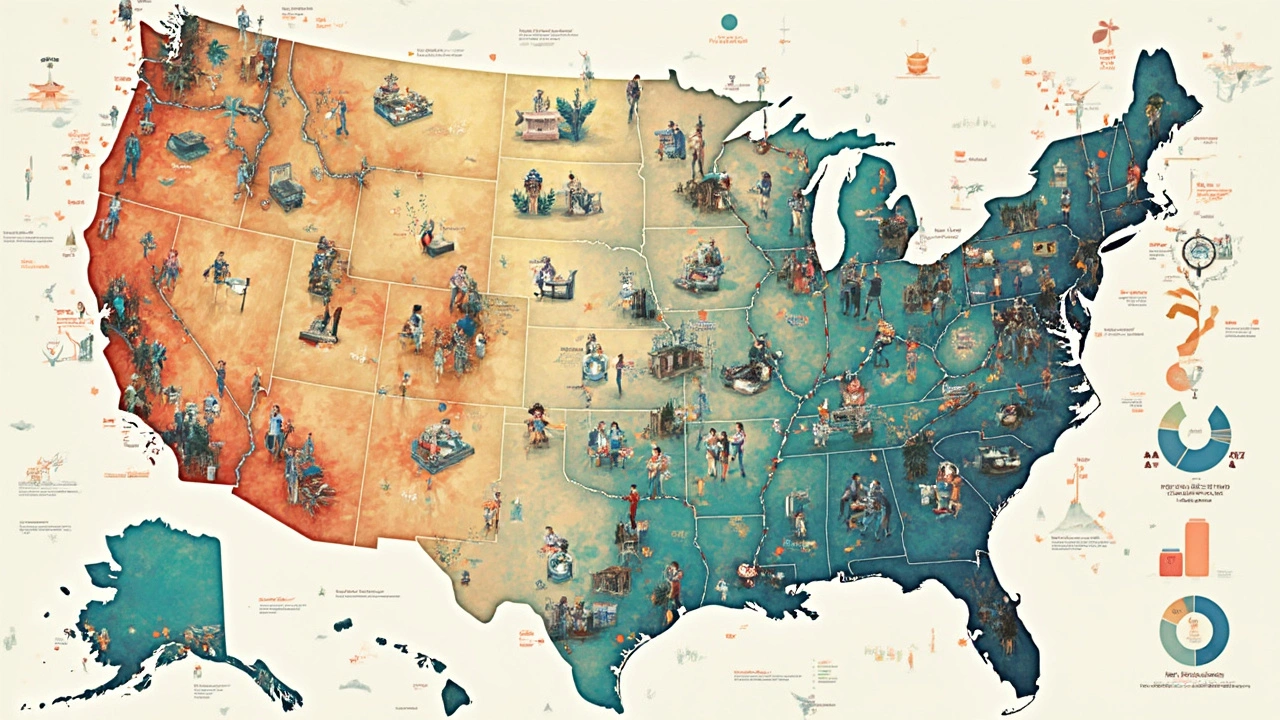
Ever wonder who actually reads USA Today these days? It's not just about having the most headlines out there—it's about knowing who's grabbing them and why. Let's dive into some alternatives to the classic 'Who is the target audience of the USA Today?' and see what these approaches can tell us.
First up, we have 'How does USA Today's audience differ regionally?' This isn't just about knowing the difference between readers in New York and Idaho. It's about understanding how preferences for sports over politics or cultural content can change depending on where you are.
Pros
- Identifies regional content opportunities.
- Helps tailor distribution strategies to high-engagement areas.
Cons
- May overlook national trends.
- Could underemphasize shared interests across regions.
- How does USA Today's audience differ regionally?
- Age-specific audience analysis
- Content type preferences across demographics
- Seasonal engagement shifts
- Digital vs. print readership dynamics
How does USA Today's audience differ regionally?
We all know the US is huge, with diverse communities and varying interests. So, it's no surprise that USA Today's target audience doesn't look the same in Los Angeles as it does in Des Moines. Regional differences shape what people want to read, and spotting these differences can be a goldmine for media outlets.
Imagine this—readers in bustling urban areas might be more into politics and international news, thanks to the faster-paced lifestyle and greater exposure to global issues. Meanwhile, rural folks may lean towards local news, sports, and agriculture-focused stories. USA Today taps into these variations by tailoring content to suit regional tastes.
Geographic segmentation provides valuable intel for strategic content planning. For instance, USA Today could boost sports coverage in areas with sports-crazy audiences or offer more in-depth political analysis where the reader demand is high.
Pros and Cons of Regional Audience Targeting
Assessing regional audience differences has its perks:
Pros
- Crafts content that resonates more deeply with specific communities.
- Improves engagement and relevance, leading to higher readership in target areas.
However, it can also present challenges:
Cons
- Your eyes might miss shared national interests by focusing too closely on local issues.
- Hard to spot overarching patterns that connect different regions.
To highlight these differences, here's a snapshot table comparing urban vs. rural engagement patterns extracted from a recent media consumption study:
| Region | Content Preference | Engagement Rate |
|---|---|---|
| Urban Areas | Political & International News | 68% |
| Rural Areas | Local News & Sports | 75% |
This design of location-focused audience segmentation helps media outlets like USA Today not just survive but thrive in a competitive media landscape, skillfully aligning their content with the interests of readers wherever they may be.
Age-specific Audience Analysis
Breaking down the age-specific audience analysis is a game-changer when it comes to understanding who actually reads USA Today and why. Different age groups have their own unique set of interests, and tapping into this can make or break engagement.
For instance, younger readers, those between 18 and 24, are more tuned into entertainment and technology. This group tends to consume news online, scrolling through headlines on their phones and reacting to viral content. Capturing their attention is all about being quick, fresh, and relatable.
Meanwhile, folks in the 25 to 40 range often juggle professional and personal commitments. They’re usually interested in business news, health updates, and lifestyle tips. They read for practical information that can impact daily decisions—whether it's managing work-life balance or financial planning.
On the flip side, the 41 to 60 age bracket often values political news, investigative journalism, and in-depth features. This group appreciates thoroughness and context in reporting. They're more likely to leaf through both the digital and print editions, savoring stories in-depth.
Pros
- Helps tailor content to the right audience.
- Improves engagement through relevancy.
Cons
- Can pigeonhole readers into stereotypes.
- Risks oversimplifying complex audience needs.
Interestingly, studies indicate that those over 60 years old still prefer print. There's something about the tactile feel of a newspaper that digital just can't replicate for them. Yet, they have begun dabbling with digital—particularly e-publications—for quick updates.
| Age Group | Primary Interest | Preferred Platform |
|---|---|---|
| 18-24 | Entertainment, Tech | Digital |
| 25-40 | Business, Health | Digital/Print |
| 41-60 | Politics, In-Depth Features | Digital/Print |
| 60+ | Traditional News, In-Depth | Print/Digital |
These insights on age-specific preferences can guide content creators to tailor what they put out, matching the medium to the message for maximum impact. Keeping these dynamics in mind ensures relevance across the board.

Content Type Preferences Across Demographics
Ever wondered what kinds of articles grab the most eyeballs from different groups of people? It's like figuring out which toppings go best on pizza—everyone's got their thing! Let's break down how different age groups, genders, and more engage with content on USA Today.
For starters, younger readers, think those in their late teens to mid-twenties, are all about digital content. These folks love fast, snackable news articles, videos, and interactive infographics. Tech and entertainment are hot topics here. No surprise, right? It's all about quick, digestible info they can share.
On the flip side, older generations, say those over 55, tend to appreciate more substantial coverage. They’re inclined towards print as well as in-depth pieces on politics and world news. USA Today still holds a soft spot for them in its traditional format. It makes sense—the Sunday morning coffee and newspaper ritual is alive and well!
Gender can play a role too. For example, a study showed that women typically engage more with health and lifestyle pieces, while men might click on tech and sports headlines more often. It’s all about tuning content to match interests, making sure everyone feels a bit of connection.
The Age Factor
Research indicates that those aged 35-44 show a balanced preference—they don't mind a good mix of both digital and print, enjoying both quick reads and deeper dives into topics of interest. Regional readership comparatives reveal a similar balance among this age group.
Understanding Preferred Formats
| Age Group | Preferred Format | Popular Topics |
|---|---|---|
| 18-24 | Digital, Interactive | Entertainment, Tech |
| 35-44 | Digital & Print | World News, Culture |
| 55+ | Politics, In-depth Analysis |
Understanding these preferences allows USA Today to craft pieces that not only inform but also resonate. The more we know about who loves what, the better we can tailor our content to bring more folks on board.
Seasonal Engagement Shifts
When it comes to USA Today's target audience, understanding how reading habits change with the seasons can provide massive insight. It's not just about what folks read, but when they're diving into articles. Picture this: summer's here, and everyone's outside soaking up the sun. So, naturally, engagement shifts a tad. Whether it's trending beach reads or outdoor activity guides, USA Today's content game can shift gear.
Over the past few years, audience behaviors have shown certain predictable patterns. During the winter months, for instance, there’s a noticeable uptick in digital consumption. Blame it on the cold weather keeping folks indoors glued to their screens. On the flip side, spring sees higher engagement with lifestyle and travel content as people start planning trips and vacations. Who doesn't love that thrill of holiday browsing?
Pros of Understanding Seasonal Engagement
- Helps tailor content strategies for different times of the year.
- Ensures timely delivery of relevant content for higher engagement rates.
- Allows better prediction of resource allocation for maximum efficiency.
Cons of Overemphasizing Seasons
- May miss out on evergreen content opportunities.
- Might lead to excessive focus on short-term trends.
For those keeping an eye on the digital vs. print readership dynamics, it’s worth noting that print takes a bit of a backseat during holiday seasons. Why? Well, digital is just more accessible for the busy holiday traveler.
| Season | Popular Content |
|---|---|
| Winter | News, technology updates |
| Spring | Lifestyle, travel guides |
| Summer | Outdoor activities, sports |
| Autumn | Education, career development |

Digital vs. Print Readership Dynamics
In a world where you can get news by just clicking a button, the difference between digital and print readership is more fascinating than ever. While digital has been growing fast, there's still a corner in the market for print lovers who appreciate the feel of paper between their fingers.
Did you know that as of 2025, approximately 60% of USA Today's readers have switched to digital platforms? This shift isn't just about convenience—it's a game-changer for how content is consumed. The digital space offers quick updates, multimedia features, and interactive content that print simply can't provide. Plus, with smartphones and tablets everywhere, reading on the go has never been easier.
But hold on, print isn't out for the count just yet. Believe it or not, there's still a steady demand for print among older generations who cherish the traditional newspaper format, not to mention the nostalgia factor. Some folks, especially in rural areas, prefer print due to patchy internet connections.
The Rise of Digital
- Instant Updates: Digital platforms ensure readers get the latest news as it happens, which keeps them hooked.
- Cost-Efficient: With print costs on the rise, digital subscriptions tend to be cheaper, drawing more budget-conscious readers.
- Interactive Experience: Videos, podcasts, and interactive articles engage users in a way print never could.
Why Print Still Matters
- Tangible Connection: The feel of paper and the traditional look are irreplaceable for some readers.
- Reliability: No need to worry about internet outages or tech issues—just solid, old-school reading.
- Focused Reading: Without the constant ding of notifications, print encourages more focused consumption.
Both digital and print have their unique perks, and tailoring content strategy to accommodate both types of audiences ensures that nobody's left in the dark. Looking ahead, knowing where your readers are coming from—both literally and figuratively—spells the difference between hitting a homer or striking out.
| Format | Reader Demographic | Engagement Level |
|---|---|---|
| Digital | 18-44 years old | High |
| 45+ years old | Moderate |